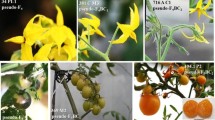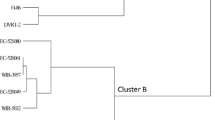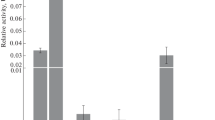Abstract
In breeding tomatoes for resistance to “Corky root” Lycopersicum glandulosum is used as a resistant parent. Crosses of tomato with L. glandulosum are difficult to effect because of the incompatibility of the partners. To overcome this incompatibility the “approach method” was applied beside the conventional crosses.
Repeated reciprocal grafting of tomato onto L. glandulosum and also L. glandulosum on tomato did not increase the number of effected matings. The statement that by repeated grafting the characters of the scion change under the influence of the stock could not be confirmed.
Similar content being viewed by others
References
Avakjan, A. A., and N. G. Jastreb, Hybridisation by means of grafts. Jarovisacia 1941: 1: 50–57 (Russian).
Alexander, L. J., and M. M. Hoover, Progress report of National Screening Committee for disease resistance in the tomato for 1952. Plant Dis. Reptr., Washington, 37 (1953): 317–324.
Baldin, P. G., Vegetative hybridisation of the tomato. Agrobiology, Moscow 1952: 4: 142–145.
Bateman, A. J., Grafting experiments between the tomato varieties Golden Apple and Oxheart. Nature 175 (1955): 1118–1120.
Böhme, H., Untersuchungen zum Problem der genetischen Bedeutung von Pfropfungen zwischen genotypisch verschiedenen Pflanzen. Z. Pflanzenz. 33 (1954): 367–418.
Brix, K., Untersuchungen über den Einfluss der Pfropfung auf Reis und Unterlage und die Möglichkeit einer Übertragung eventueler Veränderungen auf die Nachkommen. Z. Pflanzenz. 31 (1952): 261–288.
Burdick, A. B., Experimental evidence relating to one postulate of the new Russian genetics. Genetics 37 (1952): 570.
Cucin, N. V., and M. Z. Nasarova, Experiments on wide vegetative and sexual hybridisation of plants. Bull. Acad. Sci. U.R.S.S. 1953, 1: 20–25 (Russian).
Ermolaeva, N. J., An experiment in vegetative hybridisation in order to obtain economically valuable types of tomato. Jarovisacia 1941: 2 (35): 31–34 (Russian).
Fainborn, V. D., The inheritance of characters obtained by grafting in tomatoes. Trud. Inst. Genet. Leningr., 1953: 20: 210–224 (Russian).
Felföldy, L. J. M., Experiments with the first seed generation of tomato grafts. Acta. Biol. Acad. Sci. Hungar. 1951: 2: 3–53 (Hungarian).
Forlani, R., Innesti fra Solanacee. Genetica Agraria, 3 (1951): 89–92.
Glavinic, R., L'hybridisation vegetative comme méthode dans la sélection des tomates. Report of the 14th International Horticultural Congress-1955: 440–445.
Golinska, J., A description of the segregation of vegetative cross of red tomato with a yellow. Roczn. Nauk Rol. Ser. A. 68 (1954): 507–516 (Polish).
Glustschenko, I. E., The hybridisation of plants by grafting. Adv. mod. Biol., Moscow 30 (1950): 15–48 (Russian).
Hackbarth, J., Tomate-Lycopersicum esculentum Mill. Handbuch der Pflanzenzüchtung Bd 5, 1950. Berlin. 464–476.
Harkacjan, S. S., Combined action of grafting and hybridisation upon tomatoes. Sad i Ogerod 1949: 7: 47–48 (Russian).
Hasina, E. P., Repeated backgrafting as a method of intensifying changes in the heritable characters of plants. Dokl. Vsesoj. Acad. Sjelsk. Nauk im V. I. Lenina 1952: 6: 9–11 (Russian).
Haschkova, O., Grafting as a means of plant transformation. Dokl. Vsesoj. Acad. Sjelsk. Nauk. Im. V. I. Lenina 1944: 8–9: 12–18 (Russian).
Kress, H., Mitschurin-Lyssenko-Arbeiten in der Saatzucht Gülzow-Güstrow (Meckl.). Mitt. deutsch. Landwirtsch. Ges. (DLG) 3 (1990): 270–273.
Mc. Guire, D. C., and C. M. Rick, Selfincompatibility in species of Lycopersicon sect. Eriopersicon and hybrids with Lyc. esculentum. Hilgardia: 23 (1954): 101–124.
Prakken, R., Entproeven met tomaat en tabak. Studiekring voor Plantenveredeling. 20. II. 1952: 442–445.
Prjadcenku, A., Achievements of plant breeding in the Rumanian People's, Republic. Agrobiology, Moscow 1955: 4: 229–304 (Russian).
Sedljamair, K., Plant breeding in Hungary along Mitschurin's road. Agrobiology, Moscow 1955: 5: 26–31. (Russian).
Soost, R. K., Another high beta-carotene line. Rep. Tom. Genet. Coop.: 6 (1956): 29.
Sachs, L., Vegetative hybridisation in the tomato. Nature 167: 1951: 282–283.
Stubbe, H., Über die vegetatieve Hybridisierung von Pflanzen. Versuche an Tomatenmutanten. Kulturpflanze 2 (1954): 185–236.
Thung, T. H., Jaarverslag Instituut voor Plantenziektenkundig Onderzoek, Wageningen. 1954: 11–12.
Whaley, W. G., The growth of reciprocal tomato-tobacco grafts. Bull. Torrey bot. Cl. 80 (1953): 26–32.
Author information
Authors and Affiliations
Rights and permissions
About this article
Cite this article
Szteyn, K. Trials to overcome the incompatibility of crosses between Lycopersicum esculentum and Lycopersicum glandulosum by repeated grafting. Euphytica 8, 145–150 (1959). https://doi.org/10.1007/BF00022433
Received:
Issue Date:
DOI: https://doi.org/10.1007/BF00022433




